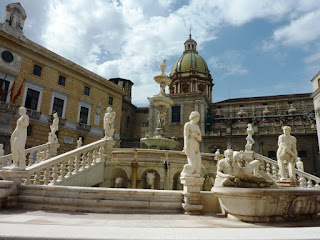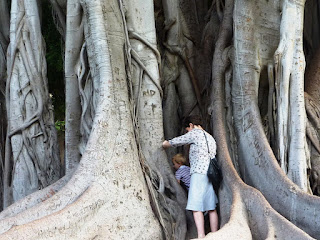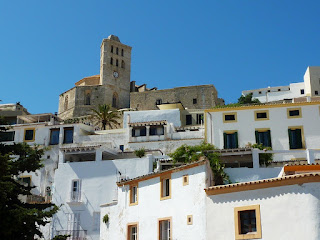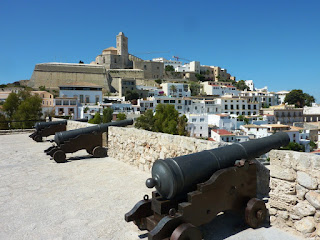The streets of Trapani
The Palazzo della Giudecca
Trapani, with its narrow
peninsular, is the capitol of its eponymous province, the most westerly region
in Sicily. Here, the Arab influence is at its strongest,
from couscous to its hybrid architecture and inhabitants. The narrow network of streets in the old
quarter remains a Moorish labyrinth and, as usual, the most attractive
buildings are the churches. The Cathedral of San Lorenzo and the Chiesa del
Collegio dei Gesuiti were both dated back to mid-1600s.
Trapani is now the base for
our stay for the next 5 days while we wait out yet another Scirocco, a strong
wind coming from North Africa. The town is
oriented around the “train station’.
There is no bus terminal and different bus lines operate from different
stops at different locations with no sign to indicate. The nearby grocery store sells mainly
non-perishable products. If you want fruit, produces, meat and/or fish, you
need to visit individual vendors. Thankfully, right around the corner near Vento
di Maestrale, the marina where we are staying, there is the central fish
market, various fruit and produce vendors in their moving vans, the local
butcher shop, coffee shop and pastry shop, just to name a few. However, Barcelona it is not.
During our stay, we visited the towns of Erice and Palermo. Erice, founded
by the Ancient Elymians, called Aphrodite by the Greeks and then Venus by the
Romans, has been called many other names.
It was called Eryx, renamed Gebel-Hamed by the Arabs, Monte San Giuliano
under the Normans, and then Erice, in 1934, by Mussolini.
The mountain village of Erice
The thousand-year old fortress built by King Aragon
The famous pastry and sweets at Erice
Erice, set at the mountaintop, 756M (2,480 ft) from Trapani, was a shrine to
Venus, the goddess of love, whose temple was once a famous landmark. In Greek times, the place was known to
mariners. It is the present site of the
Norman castle – Castello di Venere., and on a clear day, you can see all the
way to Cap Bon in Tunisia. On this howling day with wind gusting at 30
knots, we thought we should be able to accomplish that, but the sky looked hazy
and instead, we saw a ‘sun dog’, usually indicating bad weather. We still saw
lovely views at Giardino del Balio and Castello di Venere, overlooking the
rugged turrets and wooded hillsides, and the saltpans of Trapani and the sea. It was a pleasure to visit this medieval town,
with cobbled streets at every twist and turn.
If you have a sweet tooth, you might also want to visit Pasticceria
Grammatico, the world famous cafe and pasty shop, where Maria sells frutta di
martorana (marzipan fruits), and assortments of biscuits, tarts and other
delicacies.

Fontana Pretoria at Palermo, the 'fountain of shame'
The busy streets of Palermo - Quattro Canti
Il Duomo
Palermo,
founded by the Phoenicians and became an important Carthaginian stronghold
until the Roman conquered it in 254BC.
Frederick, the Norman
ruler, had built many beautiful monuments to his reign. Later, the Aragons and the Bourbons followed
suit and the city was finally liberated by Garibaldi in 1860.
Nowadays, Palermo
is best known for its mafia connection, developed as a result of the cruel
State and severe poverty. By the late 19th
century, it had become a criminal organization thriving on property speculation
and drug trafficking. We saw very little
mafia activities the day we were there.
The closest was having an afternoon coffee at the Grand Hotel, where in
the 1950s, Lucky Luciano-the capo de capi of the Cosa Nostra-notoriously
attended a meeting of gangsters.
Palazzo del Normanni
Cappella Palatina
Having coffee in the Grand Hotel
Mom, let's discover Palermo together
To some, Palermo
can be seen as noisy, dirty, and chaotic.
To others, it is a city filled with architecture delight. Some of the highpoints of our visit were
seeing the Palazzo dei Normanii, and the sumptuous interior of the Cappella
Palatina, built by Roger II, it blends Byzantine, Islamic and Norman styles,
and is lavishly adorned with fine mosaics and marble inlaid with gold. It was amusing to see the Fontana Pretoria
and the story behind how it was dubbed as “the Fountain of Shame” when the
nudity of the provocative nymphs proved too much for the Sicilian churchgoers
and the local nuns chopped off the protruding bits (and recently
restored). And the Duomo, with its
displays of multiple architectural styles, from the Gothic, to the Catalan,
Norman and Islamic, was a rival to the cathedral of Monreale, and it was known
as ‘the battle of the two cathedrals’.
The city, despite its crumbling appearance, is a treasure trove of
Baroque buildings and splendid collection of Arab-Norman buildings. We were pleased that we had the opportunity
to experience this magnificent city, in September, and not in August.
Every time we were back from a trip, the entire 3Rivers
would have a fresh coat of sea spray, solidly crested with salt, all over. The southern wind created a very humid
environment and since we were not able to open hatches/windows due to sea
spray, we were glad to make use of the AC on the boat.



















































